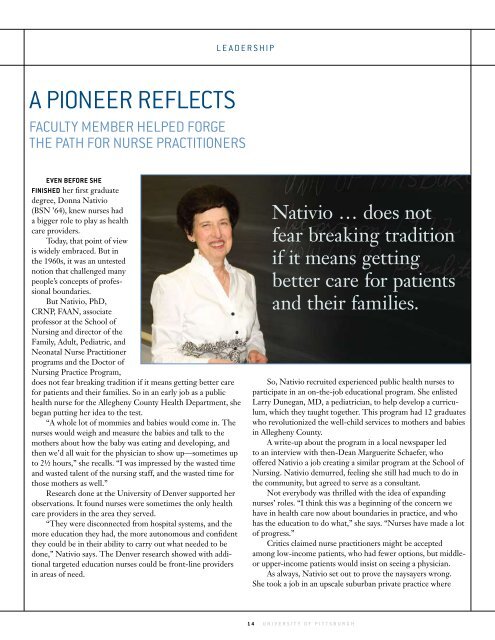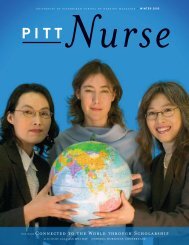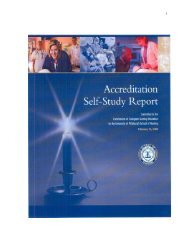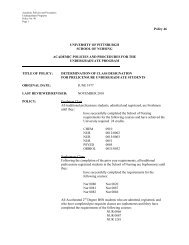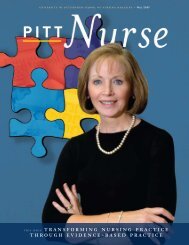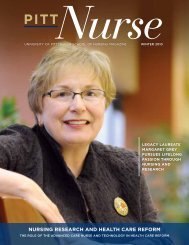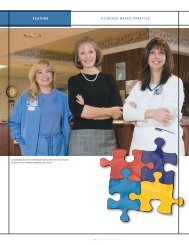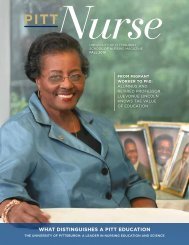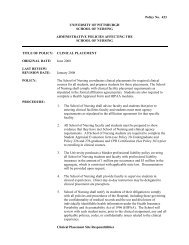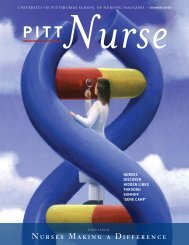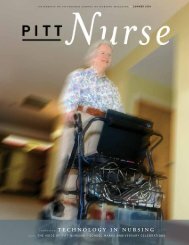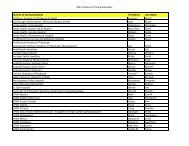LeadershipA pioneer reflectsFaculty member helped forge<strong>the</strong> path for nurse practitionersEven before shefinished her first graduatedegree, Donna Nativio(BSN ’64), knew <strong>nurses</strong> hada bigger role to play as health<strong>care</strong> providers.Today, that point <strong>of</strong> viewis widely embraced. But in<strong>the</strong> 1960s, it was an untestednotion that challenged manypeople’s concepts <strong>of</strong> pr<strong>of</strong>essionalboundaries.But Nativio, PhD,CRNP, FAAN, associatepr<strong>of</strong>essor at <strong>the</strong> <strong>School</strong> <strong>of</strong><strong>Nursing</strong> and director <strong>of</strong> <strong>the</strong>Family, Adult, Pediatric, andNeonatal Nurse Practitionerprograms and <strong>the</strong> Doctor <strong>of</strong><strong>Nursing</strong> Practice Program,does not fear breaking tradition if it means getting better <strong>care</strong>for patients and <strong>the</strong>ir families. So in an early job as a publichealth nurse for <strong>the</strong> Allegheny County Health Department, shebegan putting her idea to <strong>the</strong> test.“A whole lot <strong>of</strong> mommies and babies would come in. The<strong>nurses</strong> would weigh and measure <strong>the</strong> babies and talk to <strong>the</strong>mo<strong>the</strong>rs about how <strong>the</strong> baby was eating and developing, and<strong>the</strong>n we’d all wait for <strong>the</strong> physician to show up—sometimes upto 2½ hours,” she recalls. “I was impressed by <strong>the</strong> wasted timeand wasted talent <strong>of</strong> <strong>the</strong> <strong>nursing</strong> staff, and <strong>the</strong> wasted time forthose mo<strong>the</strong>rs as well.”Research done at <strong>the</strong> University <strong>of</strong> Denver supported herobservations. It found <strong>nurses</strong> were sometimes <strong>the</strong> only health<strong>care</strong> providers in <strong>the</strong> area <strong>the</strong>y served.“They were disconnected from hospital systems, and <strong>the</strong>more education <strong>the</strong>y had, <strong>the</strong> more autonomous and confident<strong>the</strong>y could be in <strong>the</strong>ir ability to carry out what needed to bedone,” Nativio says. The Denver research showed with additionaltargeted education <strong>nurses</strong> could be front-line providersin areas <strong>of</strong> need.Nativio … does notfear breaking traditionif it means gettingbetter <strong>care</strong> for patientsand <strong>the</strong>ir families.So, Nativio recruited experienced public health <strong>nurses</strong> toparticipate in an on-<strong>the</strong>-job educational program. She enlistedLarry Dunegan, MD, a pediatrician, to help develop a curriculum,which <strong>the</strong>y taught toge<strong>the</strong>r. This program had 12 graduateswho revolutionized <strong>the</strong> well-child services to mo<strong>the</strong>rs and babiesin Allegheny County.A write-up about <strong>the</strong> program in a local newspaper ledto an interview with <strong>the</strong>n-Dean Marguerite Schaefer, who<strong>of</strong>fered Nativio a job creating a similar program at <strong>the</strong> <strong>School</strong> <strong>of</strong><strong>Nursing</strong>. Nativio demurred, feeling she still had much to do in<strong>the</strong> community, but agreed to serve as a consultant.Not everybody was thrilled with <strong>the</strong> idea <strong>of</strong> expanding<strong>nurses</strong>’ roles. “I think this was a beginning <strong>of</strong> <strong>the</strong> concern wehave in health <strong>care</strong> now about boundaries in practice, and whohas <strong>the</strong> education to do what,” she says. “Nurses have made a lot<strong>of</strong> progress.”Critics claimed nurse practitioners might be acceptedamong low-income patients, who had fewer options, but middleorupper-income patients would insist on seeing a physician.As always, Nativio set out to prove <strong>the</strong> naysayers wrong.She took a job in an upscale suburban private practice where14 university <strong>of</strong> Pittsburgh
LeadershipNurse educator worksto address <strong>nursing</strong>shortage on both sides<strong>of</strong> <strong>the</strong> equationfor two years she successfully demonstrated that her work wasvalued by <strong>the</strong> physicians and by mo<strong>the</strong>rs across income groups.At that point, Enid Goldberg, dean <strong>of</strong> <strong>the</strong> <strong>School</strong> <strong>of</strong><strong>Nursing</strong>, <strong>of</strong>fered to put Nativio on retainer and convinced herto accept a joint appointment between <strong>the</strong> school and Children’sHospital <strong>of</strong> Pittsburgh <strong>of</strong> UPMC. In <strong>the</strong> early 1970s, Nativiobecame <strong>the</strong> second nurse practitioner hired by <strong>the</strong> hospital.Despite <strong>the</strong> resistance she met from some members <strong>of</strong> <strong>the</strong>medical and <strong>nursing</strong> staff, “<strong>the</strong> patients from <strong>the</strong> start acceptedand loved having, <strong>the</strong>ir nurse,” she says.Nurse practitioners were told to introduce <strong>the</strong>mselves bysaying, “I’m not a physician.” Nativio welcomes <strong>the</strong> opportunityto consult with physicians but is proud <strong>of</strong> her nurse practitionerrole. “I don’t mind clarifying that, as long as <strong>the</strong> physician iswilling to say, ‘I’m not a nurse practitioner,’” says Nativio.Nurse practitioners have come a long way since <strong>the</strong>n.“Today, <strong>the</strong> <strong>School</strong> <strong>of</strong> <strong>Nursing</strong>’s nurse practitioner graduates arehighly sought after, and <strong>the</strong> day-to-day relationships among <strong>the</strong>disciplines are very good, as <strong>the</strong>y work side by side with <strong>the</strong> goal<strong>of</strong> best patient outcomes,” says Nativio. “Challenges remain at<strong>the</strong> policymaking level, when decisions are made about who’s incharge and who gets reimbursed.”There have been o<strong>the</strong>r firsts for this pioneer nurse practitioner.Nativio was one <strong>of</strong> <strong>the</strong> first pediatric nurse practitionersto gain national pr<strong>of</strong>essional certification for excellence inpractice. She helped draft <strong>the</strong> first rules and regulations that arestill <strong>the</strong> basis for <strong>the</strong> legal practice <strong>of</strong> nurse practitioners in <strong>the</strong>Commonwealth <strong>of</strong> Pennsylvania. In addition, she was a foundingcoeditor <strong>of</strong> <strong>the</strong> American Journal for Nurse Practitioners anda founder (and past president) <strong>of</strong> <strong>the</strong> American College <strong>of</strong>Nurse Practitioners.Most recently, Dean Dunbar-Jacob appointed Nativio tolead ano<strong>the</strong>r first—<strong>the</strong> school’s Doctor <strong>of</strong> <strong>Nursing</strong> Practice(DNP) program. The DNP is an alternative to <strong>the</strong> PhD for<strong>nurses</strong> who plan to work in a clinical setting.Nativio continues to answer questions about <strong>the</strong> expandedrole <strong>of</strong> <strong>nurses</strong> and has testified before <strong>the</strong> state assembly aswell as <strong>the</strong> U.S. Congress. It’s a familiar role for a pioneer, andone Nativio always has embraced. She has an <strong>of</strong>fice wall full<strong>of</strong> awards, testimony to her distinguished service. And, “I have<strong>the</strong> scars to prove I’ve earned <strong>the</strong> title <strong>of</strong> nurse practitionerpioneer,” she says.“As a nurse educator,I’m <strong>the</strong> first line<strong>of</strong> ensuring qualitypatient <strong>care</strong>.”In her role as dean <strong>of</strong> health pr<strong>of</strong>essions at WestmorelandCounty Community College, Kathleen Malloy (PhD ’89,MNEd ’76, BSN ’71), RN, is working hard to draw studentsinto health <strong>care</strong> at a time when shortages are nearingcritical numbers.“As a nurse educator, I’m <strong>the</strong> first line <strong>of</strong> ensuring qualitypatient <strong>care</strong>,” she says. “If I do my job right, it leads to <strong>the</strong>continuum <strong>of</strong> <strong>nurses</strong> providing quality <strong>care</strong>,” says Malloy, whoalso was appointed four years ago by Pennsylvania Governor EdRendell to cochair <strong>the</strong> Pennsylvania Center for Health Careers,a public-private partnership intended to address <strong>the</strong> shortage.The task is one that takes some patience, for as Malloypoints out, “It takes time for students to learn—to be able toput knowledge all toge<strong>the</strong>r and <strong>the</strong>n apply it. “Teaching criticalthinking is very difficult. Just because students are computerliterate doesn’t mean <strong>the</strong>y are critical thinkers.”Malloy also contributes to a mentoring program for newfaculty that is designed to help new nurse educators and o<strong>the</strong>rfaculty adapt to <strong>the</strong>ir new roles as faculty. Mentors assist newfaculty in design and sequence objectives, matching coursecontent to <strong>the</strong> students’ abilities and deciding on instructionaldesign. The objectives help faculty members know where <strong>the</strong>yare taking <strong>the</strong>ir students and set <strong>the</strong> basis for evaluations andcompetencies.“A good objective needs to be clear to <strong>the</strong> learner,” Malloysays. “It doesn’t need to be fancy.”Thanks to <strong>the</strong> rise in evidence-based practice, those objectiveskeep changing too: “Long gone are <strong>the</strong> days when we teachsomething just because that’s <strong>the</strong> way we learned,” she says. “Ifyou are a pr<strong>of</strong>essional, you need evidence.”Pitt Nurse spring 2009 15


